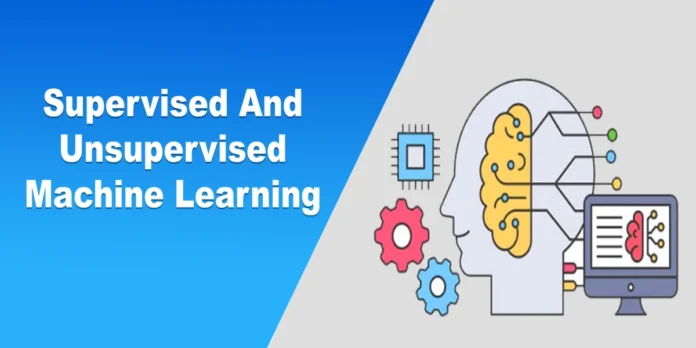Machine learning is transforming the modern world by enabling computers to learn from data and make reliable judgments without explicit programming. It is used to promote innovation in several sectors, from improving consumer experiences to streamlining business processes.
The two primary methods that underpin this technology are supervised and unsupervised learning. These methodologies shape the way machines process information, identify patterns, and make decisions.
In this blog post, I will discuss both Supervised and Unsupervised machine learning, basic ideas behind each strategy, and practical uses in everyday life.
Let’s begin!
Supervised and Unsupervised Machine Learning – An Overview
Understanding these two approaches is essential whether you’re a student, professional, or simply curious about how machines “learn.”
Supervised Learning: Directed by Labeled Data

Training algorithms using data that already has the right answers is known as supervised learning. Similar to learning with a teacher’s assistance, the model learns to provide predictions by observing instances that correspond to input data with the desired result.
How Supervised Learning Works
In order to minimize the discrepancy between its predictions and the actual response, the algorithm examines these samples and modifies its internal parameters. This technique allows it to continue making precise predictions when it encounters fresh data as it gets experience.
Key Applications
- Spam Detection: Determining if an email is spam or not.
- Medical Diagnosis: Predicting illnesses using patient data.
- Credit Scoring: Predicting the probability of loan payback.
- Image Recognition: Identifying objects within images.
Benefits of Supervised Learning
- Extremely precise with enough labeled information.
- Unambiguous evaluation metrics (recall, accuracy, and precision).
- Dependable when it comes to making predictions.
Unsupervised Learning: Uncovering Hidden Trends
When there is no labeled data to direct the process, unsupervised learning takes over. The program looks for hidden patterns, groups, or underlying structures in the data without being informed what the “right answer” is.

How Unsupervised Learning Works
The data is analyzed by the algorithm to find relationships, trends, or groups. Instead, depending on outside direction, it looks for patterns in the inherent characteristics of the data.
Key Applications
- Customer segmentation: Putting people into groups according to their actions.
- Anomaly detection: Identifying fraudulent transactions.
- Market Basket Analysis: Finding products that are frequently purchased.
- Clustering documents: Arranging articles according to subjects.
Benefits of Unsupervised Learning
- Labeled data is not necessary.
- Excellent for examining undiscovered patterns.
- Aids in data simplification and dimensionality reduction.
Comparative Overview: Supervised vs. Unsupervised Learning
| Feature | Supervised Learning | Unsupervised Learning |
| Dataset | It uses structured, labeled data | It uses raw, unlabeled data |
| Objective | It aims to predict specific results. | It aims to predict hidden relationships or structures. |
| Output | It gives accurate outcomes (e.g., forecasts, classifications). | It gives outputs like data patterns, relationships, or clusters. |
| Input | Manual data labeling is necessary. | It does not need labeling after setup. |
| Applications | It is used in email spam filters, credit scoring and fraud detection. | It is used in market segmentation and anomaly detection. |
Which Approach Is Right for You?
The availability of data and the objectives of your project will determine this:
Choose Supervised Learning if:
- You have historical data with accurate responses.
- You require precise classifications or predictions.
- The nature of your problem is well established.
Choose Unsupervised Learning if:
- Without any prior information, you’re examining data.
- You are looking for anomalies or groups.
- Data labeling would be too expensive and time-consuming.
Both kinds are combined in many real-world systems. Unsupervised learning, for instance, can first spot patterns that are then improved by supervised methods.
Why You Should Care
Whatever your background, knowing how machine learning operates may be extremely beneficial, whether you’re a student trying to keep on top of trends, a digital marketer attempting to customize digital marketing campaigns, a developer creating smart software, or an entrepreneur navigating a cutthroat industry. Its rationale is understandable even if you are not a data scientist. Machine learning is fundamentally about finding significant patterns in data and applying that knowledge to make more informed judgments.
Machine learning is becoming more and more important as sectors and organizations depend more and more on data to guide everything from consumer interaction to product creation. It’s not some ethereal, sophisticated technology that’s only used by scholars and IT behemoths; rather, it’s quickly becoming a necessary tool for solving problems in daily work.
Its biggest strength is its accessibility; once you understand the basics, you can start to see how it applies to your field and how it may boost your creativity and productivity.
Machine learning is more than just a fad. You become more valuable to customers or businesses as well as to your capacity to make decisions with confidence and have an impact, the faster you understand its principles and potential in today’s data-rich world.
Summing It Up
Unsupervised and supervised learning are the two main foundations of machine learning. While the former helps uncover hidden insights in raw data, the latter focuses on precise forecasts with known outcomes. When combined, they improve a machine’s responsiveness, intelligence, and adaptability.
Now that you know the difference, it’s up to you to determine what to do. Begin small, experiment with Python and Scikit-learn, study basic models, and build your confidence. Along with understanding machine learning, you will eventually be able to use it to solve real-world problems.
Stay curious. Never stop learning. You are creating the future by understanding how machines learn.

